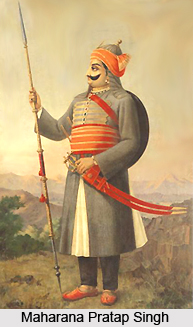 History of Pali district can be traced right back to the age of the Mahabharata. It traces its origin from baalla desh, a part of ancient Arbuda Province. The Pandavas of Mahabharata had made this area (near Bali) their resting place during their exile. Geologists trace the existence of Pali to the pre-historic age and maintain that it has emerged from the vast western sea spread over a large part of present day Rajasthan. In the Vedic age Maharsi Javali stayed in this area for meditation and interpretation of the Vedas. Historical relics depict the existence of this area during the age of the Kushana Empire, when King Kanishka had conquered Rohat and Jaitaran area, parts of today`s Pali district, in 120 AD. Till the end of the seventh century A. D., this area was ruled by the King Harshavardhana of the Chalukya dynasty who also conquered Bhinmal and most of the present area of Rajasthan.
History of Pali district can be traced right back to the age of the Mahabharata. It traces its origin from baalla desh, a part of ancient Arbuda Province. The Pandavas of Mahabharata had made this area (near Bali) their resting place during their exile. Geologists trace the existence of Pali to the pre-historic age and maintain that it has emerged from the vast western sea spread over a large part of present day Rajasthan. In the Vedic age Maharsi Javali stayed in this area for meditation and interpretation of the Vedas. Historical relics depict the existence of this area during the age of the Kushana Empire, when King Kanishka had conquered Rohat and Jaitaran area, parts of today`s Pali district, in 120 AD. Till the end of the seventh century A. D., this area was ruled by the King Harshavardhana of the Chalukya dynasty who also conquered Bhinmal and most of the present area of Rajasthan.
After the Arab invasion of India, this area was completely focussed on and occupied by Rajput rulers from all over India. During the period from 10th to the 15th centuries, boundaries of Pali extended to adjoining Mewar, Godwad and Marwar. All Rajput rulers resisted the foreign invaders but individually fought for each other`s land and leadership. After the defeat of Prithviraj Chauhan, the great warrior, by Muhamad Ghori, the Rajput power of the area was disintegrated and Mewar and Godwad area of Pali become the subjects of the ruler of Mewar, Maharana Kumbha. But Pali city which was ruled by Brahmin rulers with the patronage of the neighbouring Rajput rulers, remained peaceful and progressive.
The 16th and 17th centuries saw a number of battles in the surrounding areas of Pali. Shershah Suri was defeated by Rajput rulers in the Battle of Gini, Mughal emperor Akbar`s army had constant battles with Maharana Pratap Singh in Godwad area. Again, after the Mughals had conquered almost all of Rajputana, Veer Durga Das Rathores of Marwar made organized efforts to redeem the Marwar area from Aurangzeb. By then Pali had become subservient to the Rathores of Marwar state. Pali was rehabilitated by Maharaja Vijay Singh and soon it became an important commercial centre.
Pali district had an important role to play in the Indian freedom struggle. Under British rule, Pali a pioneering role in the freedom struggle in Marwar. Various Thakurs of pali under the stewardship of Thakur of Auwa, who was the most powerful of all, confronted the British rule. Auwa fort was surrounded by the British army and the following conflicts lasted for 5 days, when at last the fort was possessed by the British army. But this heroic action of Auwa paved the way for continued and organised struggle for freedom. Before the formation of Rajasthan Pali was a part of the erstwhile Marwar state.



















